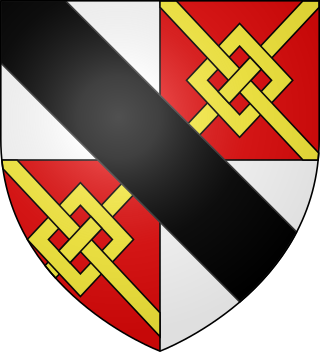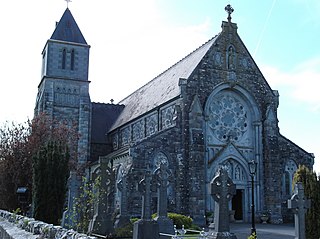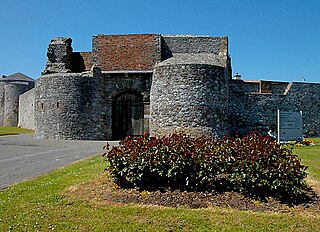
Piers Gaveston, 1st Earl of Cornwall was an English nobleman of Gascon origin, and the favourite of Edward II of England.

Edmund Fitzalan, 2nd Earl of Arundel was an English nobleman prominent in the conflict between King Edward II and his barons. His father, Richard Fitzalan, 1st Earl of Arundel, died in 1302, while Edmund was still a minor. He, therefore, became a ward of John de Warenne, Earl of Surrey, and married Warenne's granddaughter, Alice. In 1306 he was styled Earl of Arundel, and served under Edward I in the Scottish Wars, for which he was richly rewarded.
The Lord High Chancellor of Ireland was the highest judicial office in Ireland until the establishment of the Irish Free State in 1922. From 1721 to 1801, it was also the highest political office of the Irish Parliament: the Chancellor was Speaker of the Irish House of Lords. The Lord Chancellor was also Lord Keeper of the Great Seal of Ireland. In all three respects, the office mirrored the Lord High Chancellor of Great Britain.

Hugh le Despenser, sometimes referred to as "the Elder Despenser", was for a time the chief adviser to King Edward II of England. He was created a baron in 1295 and Earl of Winchester in 1322. One day after being captured by forces loyal to Sir Roger Mortimer and Edward's wife, Queen Isabella, who were leading a rebellion against Edward, he was hanged and then beheaded.
Alexander de Bicknor was an official in the Plantagenet kingdom under Edward I of England, Edward II of England, and Edward III of England. Best known to history as the Archbishop of Dublin from 1317 until his death in 1349, his career involved extensive diplomatic missions for the King and the holding of numerous civil and ecclesiastical offices in Ireland, including Lord Treasurer of Ireland (1307–1309) and Lord Chancellor of Ireland.
Events from the 1310s in England.
Edmund Butler, 6th Chief Butler of Ireland and nominally Earl of Carrick, was an Irish magnate who served as Justiciar of Ireland during the difficult times of the Scottish invasion from 1315 to 1318 and the great famine of 1316 to 1317.

Thomas Cantock, Quantock or Cantok was an English-born cleric and judge in medieval Ireland, who held the offices of Bishop of Emly and Lord Chancellor of Ireland.

John Colton was a leading English-born academic, statesman and cleric of the fourteenth century. He was the first Master of Gonville and Caius College, Cambridge. He spent much of his career in Ireland, where he held the offices of Treasurer of Ireland, Lord Chancellor of Ireland and Archbishop of Armagh. He is chiefly remembered today for his book The Visitation of Derry (1397), which he either wrote or commissioned.
Richard de Beresford or Bereford was an English-born cleric and judge who held high political office in Ireland in the early fourteenth century as Lord High Treasurer of Ireland and Lord Chancellor of Ireland.

Sir John Wogan or John de Wogan, styled lord of Picton was a Cambro-Norman judge who served as Justiciar of Ireland from 1295 to 1313.
William de Rodyard, de Rodiard, or de Rudyard was an English-born judge and cleric in fourteenth-century Ireland. He held office as Chief Justice of the Irish Common Pleas. He was also Dean of St Patrick's Cathedral, and briefly Deputy Lord Treasurer of Ireland. He was the first Chancellor of the Medieval University of Dublin.

Adam de Harvington, also called Adam de Herwynton (c.1270-c.1345) was a fourteenth-century Crown official and judge who had a successful career in both England and Ireland. He held office as Chief Baron of the Irish Exchequer and Lord Treasurer of Ireland, and as Chancellor of the Exchequer of England, and acquired considerable wealth.
John Keppock was an Irish judge of the late fourteenth century, who held the offices of Lord Chief Justice of Ireland, Chief Baron of the Irish Exchequer and Deputy Lord Chancellor of Ireland. He became a politician of some importance.
Geoffrey de Morton was a wealthy merchant and shipowner in early fourteenth-century Dublin who served as Mayor of Dublin in 1303.
John de Ponz, also called John de Ponte, John Savan, or John of Bridgwater (c.1248–1307) was an English-born administrator, lawyer and judge in the reign of King Edward I. He served in the Royal Household in England for several years before moving to Ireland, where he practised in the Royal Courts as the King's Serjeant-at-law (Ireland). He later served as a justice in eyre, and then as a justice of the Court of Common Pleas (Ireland). He was a gifted lawyer, but as a judge was accused of acting unjustly. A case he heard in Kilkenny in 1302 can be seen as a precursor of the Kilkenny Witchcraft Trials of 1324, and involved several of the main actors in the Trials.
Walter de Cusack was an Anglo-Irish judge, magnate and military commander of the fourteenth century.

Sir Walter de la Haye, or de Haye was an English-born statesman and judge in Ireland of the late thirteenth and early fourteenth centuries, who served for many years as Sheriff of County Waterford and as Chief Escheator of Ireland, and briefly as Justiciar of Ireland.
William Alysaundre or Alesander was an Irish judge and Crown official in the reigns of King Edward I of England and his son Edward II.

Sir William de Essendon, de Estdene or Eastdean was an English-born cleric, lawyer and Crown official, much of whose career was spent in Ireland in the reign of Edward I of England and his son. He served twice as Lord High Treasurer of Ireland, and had a high reputation for integrity and efficiency.









